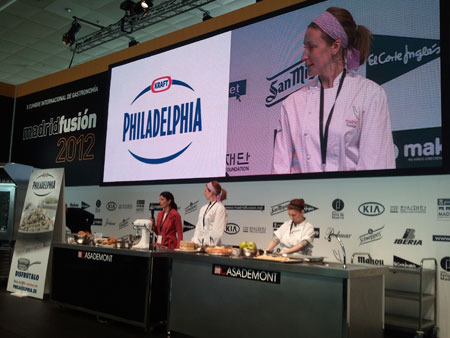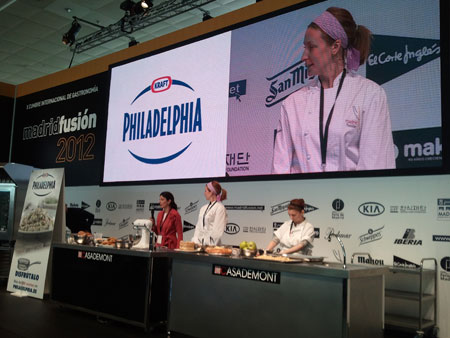Madrid Fusión 2012: Day Two
We may receive a commission on purchases made from links.
Just for a minute, sitting in the auditorium at Madrid Fusión Wednesday, watching Nathan Myhrvold (above) captivating the audience, it occurred to me to wonder if maybe he, and not René Redzepi or some other accomplished chef, were the real heir to Ferran Adrià. He has taken the Adrian concern with understanding the processes by which raw materials become finished food, that is, and run with it. (Adrià himself was spotted in Madrid yesterday, but he is staying far away from the show.)
Myhrvold, of course, isn't a professional chef — though he revealed to the group that he had cooked an entire Thanksgiving dinner for his family at the age of 9 ("It wasn't very good") and later gone to the La Varenne cooking school in France — but rather the author of the massive six-volume masterwork Modernist Cuisine. Its weight (43 pounds) and number of pages (2,438) have been widely reported; Myhrvold added the "fun facts" that the ink used to print it would itself weigh 2 kilograms (nearly 2.5 pounds) and that if all the text were laid end to end it would stretch for 12.5 kilometers (about 7.75 miles). This was all part of his volume-by-volume explanation of the work, with demonstrations along the way.
Click here for the coverage of day one at Madrid Fusión 2012
He is a riveting speaker, animated and witty, not in the least pretentious, and with the rare gift of being able to explain scientific concepts clearly without condescending to his listeners. The audience sat rapt as he explained the importance of studying the role of water in the cooking process (1 milliliter of water, he revealed, expands into 1.6 liters of steam when boiled); showed photos of his machine shop and test kitchen, both of which look like factory floors; illustrated the process of producing the cutaway pots and pans for which the book is famous; and informed us, as an illustration of the kinds of simple knowledge any cook should know, that a four-inch steak takes four times as long to cook as a two-inch one.
With his book collaborator Maxime Bilet helping, Myhrvold demonstrated — both live onstage and with video — such processes as pressure rendering, in which he turned bacon into its fat and bits of crisp meat in a jar inside a pressure cooker (the meats crisps thanks to the addition of baking soda); and centrifuging. In this case, a vial of puréed fresh peas was separated into juice, starch, and "pea butter," which Myhrvold explained wasn't really fat but behaved like it and had a fat-like richness in the mouth. The starch, he explained, partially blocks the flavor of the peas, though it could be used, along with gluten and a bit of the juice to make ravioli skins. (This seemed to trump Adrià's once-groundbreaking spherified pea ravioli — another approach to stripping away non-pea flavors.) Then there was a demonstration of cryofrying, in which a steak was cooked sous-vide, then browned without its interior cooking further, through the use of alternating baths of liquid nitrogen and boiling oil). The resulting hunk of meat looked beautiful, mahogany brown on the outside and an even juicy red inside. I suppose the question is, how much trouble and expense are you willing to go to — assuming that you're not an ex-Microsoft Croesus like Myhrvold — to avoid an extra eighth of an inch of gray meat inside your rib-eye.
When someone asked Myhrvold why he had written Modernist Cuisine, he replied "I would have been happy to be a customer for the book. It would have been much easier for me to just buy it. But it didn't exist. There was so much about cooking that I decided really needed to be explained, and it didn't seem like anyone else was going to do it."
One Madrid Fusión official, begging anonymity for obvious reasons, said he thought that Myhrvold's turn was better than anything Adrià had ever done at the conference. And an American journalist who has been coming to the event for years told me, "That was the best presentation of any kind I've ever seen here."
It was something of an Anglophone morning. Christina Tosi (above), from Momofuku Milk Bar, gave a demonstration of some of her signature desserts, sponsored by Philadelphia Cream Cheese. "Momofuku is a small restaurant in the United States, in New York City," she began. Her translator noted that she had once worked for "David Boulud". The audience watched attentively as Tosi explained her philosophy of sweet deconstruction, then put together an apple pie cake. Stressing that she brought both formal training and home baking roots to her craft, she described the importance of pie in American home cooking, and went on to reveal the secrets of her blueberry pie cookies and sweet potato pie ice cream. (Photo above courtesy of Colman Andrews)
Heston Blumenthal was onstage later, answering questions posed by journalists Teresa de la Cierva and Victor de la Serna (the latter of whom speaks unaccented colloquial American English). To a question about the entertainment value of his food, he replied that "It comes down to taste. It doesn't matter what the techniques are." He did add that "Ultimately as a chef you want to give the diner pleasure, and at The Fat Duck that includes a sense of fun." He didn't say much that hasn't been said before, either by or about him. He did mention, however, the dinner he produced for television at which the apéritif was to be licked off the dining room wallpaper. On the next April Fool's Day, he said, The Sun (a Rupert Murdoch tabloid) claimed to have collaborated with him to produce the world's first lickable newspaper page. A friend of his reported to Blumenthal that he'd seen three people on the Tube actually licking the paper. "I wanted to do it myself," he confessed, "even though I knew it was a joke."
Magnus Ek, whose 44-seat restaurant Oaxen Skärgårdskrog, on the Swedish island of Oaxen about an hour's drive south of Stockholm, is often mentioned by cognoscenti in the same breath with René Redzepi's Noma in Copenhagen. Like Redzepi, Ek forages for local plants and revives traditional methods of preservation and preparation in creating his very modern menus. Unlike him, he has no Michelin stars, and has thus far remained little known outside a small circle.
Looking a bit like a diminutive Heston Blumenthal, Ek gave a lucid, straightforward presentation toward the end of the day, demonstrating a typical three-course menu. First came an onion roasted in parchment, meant to be cut open in the dining room and garnished with thin slices of cold-smoked pork fat and sprinkled with hazelnuts. The second course was pure Scandinavia: Ek smeared a plate with buttermilk curd ("We make a lot of butter at the restaurant just to get buttermilk, which I love," he confessed), then added a tangle of blanched and lightly sautéed oak moss, a variety of lichen that grows on sloe trees (he and his chefs harvest it from a neighboring island). This was garnished with lumpfish roe, salted, and mixed with grapeseed oil. Then the main ingredient was added — thin slices of salted, cold-smoked, dried reindeer heart. Over the top of everything went some mushroom powder ("To bring out the mushroom flavor of the lichen") and sprigs of wood sorrel. It all looked rather strange but delicious.
Ek's main course was described as "birch bark old cow, baked Jerusalem artichokes, and Jerusalem artichoke purée with smoked ox marrow and dried cherries." "We think that old cow [the phrase probably sounds more appetizing in Swedish], one that has had two or three calves, has the best flavor," said Ek. The meat is hung for six or seven weeks, then slow-cooked sous-vide with herbs. He removes it from the vacuum bag, wraps it in big curls of birch bark originally meant for roofing, then incinerates the outside of the bark with a kitchen blowtorch. "This is like Stone Age cooking," he says. He finishes the meat in the oven, meanwhile stirring the marrow, cherries, and some green juniper berries into the purée. Dried pork skin is sprinkled on top. When Ek cuts the birch bark cylinders open, right down the middle with a large sharp knife, the meat comes out looking... well, pretty much as gorgeous, brown on the outside and red within, as Myhrvold's had.
Click here for the coverage of day one at Madrid Fusión 2012

